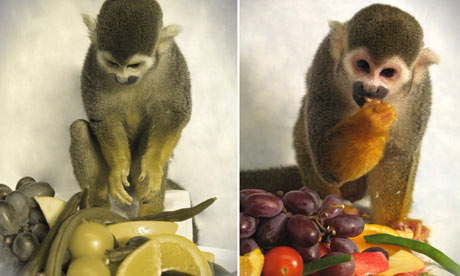
Two squirrel monkeys that were colour-blind from birth have had their vision restored after receiving gene therapy.
The experiment paves the way for the treatment of a range of genetic eye disorders in humans, including some that cause full or partial blindness in millions of people worldwide.
Sam and Dalton, two male squirrel monkeys, were able to see the world in full colour five months after being treated, doctors said. The animals were born without an ability to see the colour red.
The therapy targets specialised "cone" cells in the eye which allow animals – including humans – to see in colour.
Genetic damage to cone cells, which causes colour blindness, is the most common type of gene disorder seen in humans. The condition mostly affects men, around 5% of whom are unable to distinguish between red and green hues.
"Although colour blindness is only moderately life-altering, we've shown we can cure a cone disease in a primate, and that it can be done very safely," said William Hauswirth at the University of Florida. "That's extremely encouraging for the development of therapies for human cone [diseases] that are really blinding."
Researchers treated the monkeys by injecting them with a virus that had been modified to carry a corrective gene. When injected behind the retina at the back of the eye, the gene produces a protein that is sensitive to red light.
Doctors spent nearly 10 years training the monkeys to take colour vision tests, which were used to assess how well they responded to the treatment.
The tests are similar to those given to schoolchildren, where students are required to pick out patterns of coloured spots amid a background of dots that vary in size and hue.
Twenty weeks after the treatment, Sam and Dalton were able to tell the difference between green and red hues for the first time, according to a report in the journal Nature.
"It was as if they woke up and saw these new colours. The treated animals unquestionably responded to colours that had been invisible to them," said Jay Neitz, a co-author on the study at the University of Washington in Seattle.
The researchers have begun clinical trials to test the gene therapy as a treatment for a rare form of childhood blindness.

